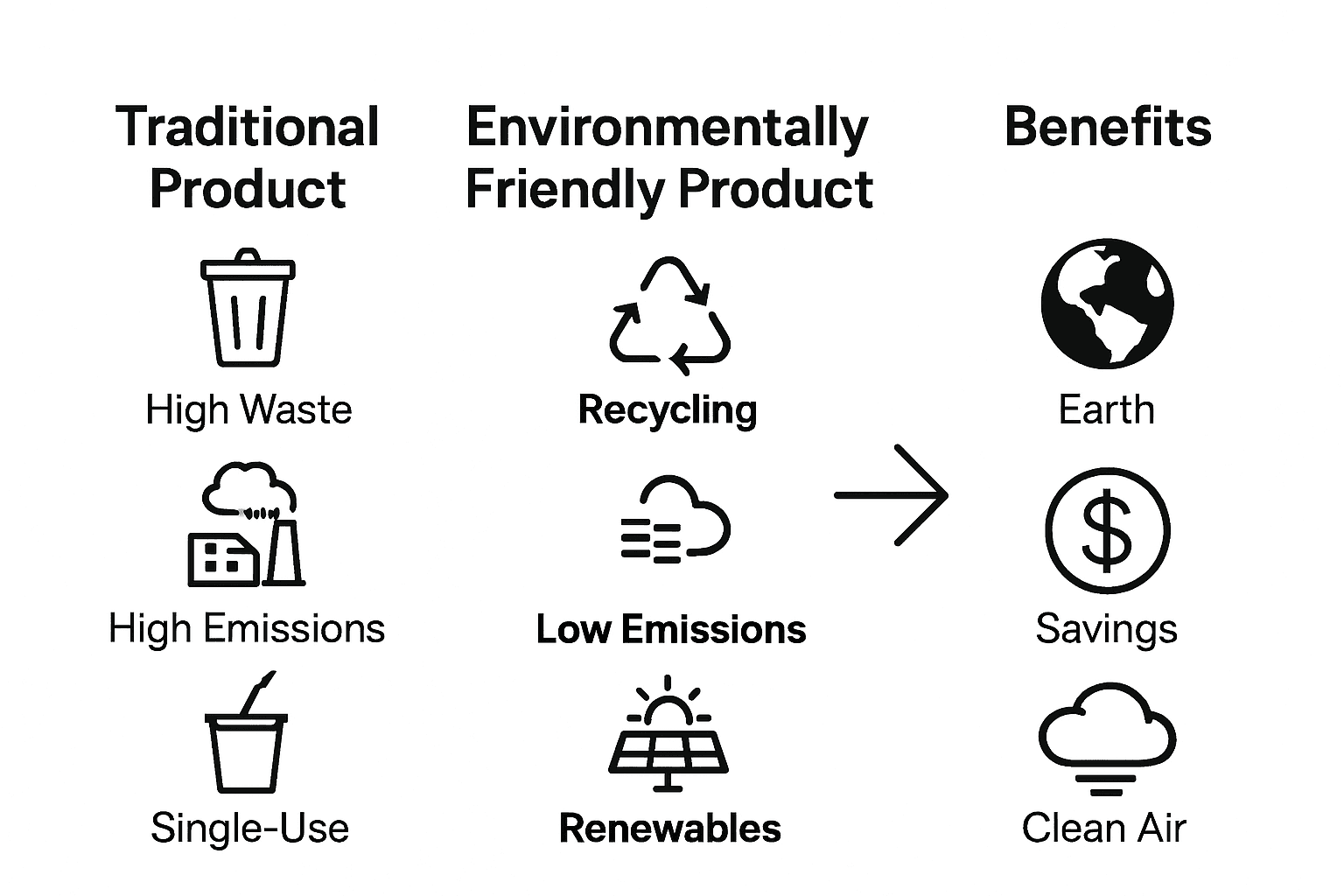What is Environmentally Friendly Products? Understanding Their Importance

Environmentally friendly products are everywhere right now and their popularity is growing for a good reason. In fact, the global market for sustainable products is expanding so quickly that investments in green businesses are outpacing traditional sectors, with new opportunities emerging every year. Most people think it all comes down to recycled materials and less waste but the truth is that real eco-friendly products go much deeper than a green label and actually transform the way businesses, economies, and our daily lives work behind the scenes.
Table of Contents
- Defining Environmentally Friendly Products
- The Importance Of Environmentally Friendly Products
- Key Characteristics Of Environmentally Friendly Products
- The Impact Of Environmentally Friendly Products On Business
- Challenges In Implementing Environmentally Friendly Practices
Quick Summary
| Takeaway | Explanation |
|---|---|
| Minimize environmental impact in product design | Focus on reducing waste and energy consumption during product creation and use to enhance sustainability. |
| Use sustainable materials for sourcing | Prioritize renewable, recyclable, or biodegradable materials to prevent depletion of natural resources. |
| Consider the entire lifecycle of products | Evaluate environmental impacts from raw material extraction to disposal for genuine ecological accountability. |
| Adopt energy-efficient practices | Design products to reduce energy use, enhancing performance while supporting environmental goals. |
| Embrace a circular economy approach | Build products for repair, reuse, and recycling to minimize waste and maximize resource efficiency. |
Defining Environmentally Friendly Products
Environmentally friendly products are solutions designed to minimize negative impacts on human health and the global ecosystem throughout their entire lifecycle. These products prioritize sustainability, reducing carbon footprints, and promoting responsible consumption patterns that support environmental preservation.
Core Characteristics of Environmentally Friendly Products
Environmentally friendly products are distinguished by several fundamental characteristics that set them apart from conventional alternatives. These characteristics represent a holistic approach to product design and manufacturing that considers ecological impact at every stage.
The following table summarizes and organizes the core characteristics distinguishing environmentally friendly products, helping clarify what sets them apart from conventional alternatives.
| Characteristic | Description |
|---|---|
| Minimal Environmental Impact | Reduced waste, lower energy use, and decreased greenhouse gas emissions in production and use |
| Sustainable Material Sourcing | Use of renewable, recyclable, or biodegradable materials that do not exhaust natural resources |
| Long-Term Durability | Extended product lifecycles minimize the frequency of replacement and generate less waste |
| Energy Efficiency | Lower energy requirements throughout both manufacturing and product operation |
| Circular Design | Built for repair, reuse, and recycling to enable more effective resource use |
| Safe Chemical Composition | Avoidance of toxic or environmentally harmful substances in every stage of the product lifecycle |
| Transparent Production Process | Clear information on sourcing, manufacturing, and environmental impacts |

Key Defining Elements:
- Minimal Environmental Impact: Products that generate reduced waste, consume less energy, and produce lower greenhouse gas emissions during production and use
- Sustainable Material Sourcing: Utilizing renewable, recyclable, or biodegradable materials that do not deplete natural resources
- Long-Term Durability: Designed to have extended lifecycles, reducing the frequency of replacement and subsequent waste generation
Lifecycle Considerations
Understanding environmentally friendly products requires examining their entire lifecycle from raw material extraction through production, distribution, usage, and eventual disposal. The Environmental Protection Agency emphasizes that true environmental friendliness encompasses comprehensive ecological considerations beyond simple marketing claims.
Manufacturers committed to creating environmentally friendly products must evaluate multiple dimensions including:
- Carbon emissions during manufacturing
- Water and energy consumption
- Potential for recycling or composting
- Chemical composition and potential ecological harm
- Transportation and distribution efficiency
These comprehensive assessments ensure that products genuinely contribute to environmental sustainability rather than merely presenting superficial green credentials.
By adopting a rigorous, multifaceted approach to product development, companies can create solutions that genuinely protect and support our planetary ecosystem.
The Importance of Environmentally Friendly Products
Environmentally friendly products represent a critical strategy for addressing global environmental challenges and promoting sustainable development. Their significance extends far beyond individual consumer choices, encompassing broader ecological, economic, and social implications that shape our collective future.
Global Environmental Protection
The adoption of environmentally friendly products plays a pivotal role in mitigating climate change and preserving natural ecosystems. By reducing carbon emissions, minimizing waste generation, and supporting responsible resource management, these products contribute directly to environmental conservation efforts.
Critical Environmental Benefits:
- Reduction of greenhouse gas emissions
- Conservation of natural resources
- Minimization of pollution and ecological degradation
- Promotion of sustainable production practices
- Support for biodiversity preservation
Economic and Social Implications
Beyond environmental protection, environmentally friendly products drive significant economic and social transformations. According to the United Nations Environment Programme, sustainable product development creates innovative economic opportunities and supports the transition towards a green economy.
Businesses and industries that prioritize environmentally friendly solutions experience multiple strategic advantages:
- Enhanced brand reputation and consumer trust
- Reduced long-term operational costs
- Compliance with emerging environmental regulations
- Access to growing sustainable market segments
- Attraction of environmentally conscious investors
Individual and Collective Responsibility
Choosing environmentally friendly products represents a tangible way for individuals, businesses, and governments to demonstrate environmental stewardship. Each purchasing decision becomes an opportunity to support sustainable practices and drive meaningful ecological change.
By consistently selecting products designed with environmental considerations, consumers and organizations can collectively create substantial positive impact. This approach transforms individual choices into a powerful mechanism for promoting global environmental sustainability and protecting our planet’s delicate ecological balance.
Key Characteristics of Environmentally Friendly Products
Environmentally friendly products are distinguished by a comprehensive set of characteristics that go beyond superficial marketing claims. These defining attributes ensure genuine environmental responsibility and sustainable product design across multiple dimensions of production and consumption.
Material Composition and Sourcing
The fundamental foundation of environmentally friendly products lies in their material selection and sourcing strategies. Manufacturers committed to sustainability prioritize materials that minimize ecological harm and support responsible resource management.
Essential Material Considerations:
- Use of renewable or recycled raw materials
- Minimal extraction of virgin resources
- Avoidance of toxic or environmentally harmful substances
- Preference for biodegradable or easily recyclable components
- Transparency in material origin and production processes
Energy Efficiency and Performance
Environmentally friendly products are engineered to deliver optimal performance while minimizing energy consumption and environmental impact. The Environmental Protection Agency emphasizes the critical role of energy efficiency in determining a product’s overall environmental credentials.
Key performance metrics for environmentally friendly products include:
- Reduced energy consumption during manufacturing
- Lower operational energy requirements
- Potential for energy regeneration or minimal energy waste
- Extended product lifecycle reducing replacement frequency
- Compatibility with renewable energy systems
Lifecycle and Waste Management
A holistic approach to environmental friendliness requires considering the entire product lifecycle from creation to eventual disposal. Sustainable products are designed with circular economy principles, ensuring minimal waste generation and maximum resource utilization.
This approach encompasses comprehensive strategies such as:
- Designing products for easy repair and refurbishment
- Creating modular components that can be individually replaced
- Establishing clear recycling or composting pathways
- Minimizing packaging waste
- Supporting closed-loop production systems
By integrating these multifaceted characteristics, environmentally friendly products transcend traditional manufacturing paradigms, offering solutions that protect ecological systems while meeting consumer and industrial needs.
The Impact of Environmentally Friendly Products on Business
Environmentally friendly products are transforming business landscapes, compelling organizations to rethink traditional operational strategies and embrace sustainable innovation. This paradigm shift represents more than an ethical choice it is becoming a fundamental competitive advantage in modern markets.
Strategic Business Transformation
Companies integrating environmentally friendly products into their portfolios experience profound operational and strategic benefits. These transformations extend beyond simple product modifications, fundamentally reimagining business models and value propositions.
Strategic Advantages:
- Enhanced brand reputation and market differentiation
- Attraction of environmentally conscious consumer segments
- Potential for premium pricing strategies
- Reduced long-term operational costs
- Improved risk management and regulatory compliance
Economic Opportunities and Market Dynamics
According to the International Finance Corporation, businesses investing in sustainable products unlock significant economic opportunities. The global market for environmentally friendly solutions continues to expand, creating robust financial incentives for innovative companies.
Key economic considerations include:
- Growing consumer demand for sustainable products
- Increased investor interest in environmentally responsible companies
- Potential for accessing new market segments
- Reduced operational risks associated with environmental regulations
- Enhanced long-term financial sustainability
Innovation and Competitive Advantage
Environmentally friendly products drive technological innovation and create distinctive competitive advantages. Businesses that proactively develop sustainable solutions position themselves as industry leaders, attracting talent, investment, and forward-thinking customers.
This approach involves:
- Investing in research and development of sustainable technologies
- Developing circular economy business models
- Creating products with minimal environmental footprint
- Establishing transparent supply chain practices
- Continuously improving environmental performance
By embracing environmentally friendly products, businesses do not merely adapt to market changes they become architects of a more sustainable economic future.

Challenges in Implementing Environmentally Friendly Practices
Despite growing recognition of environmental sustainability, organizations face numerous complex challenges when attempting to implement genuinely environmentally friendly practices. These obstacles span technological, economic, cultural, and systemic dimensions, requiring comprehensive and strategic approaches to overcome.
Economic and Financial Barriers
The transition to environmentally friendly practices often demands significant financial investments that can deter businesses, particularly small and medium enterprises. Initial implementation costs frequently represent a substantial barrier to sustainable transformation.
Financial Challenge Dimensions:
- High upfront infrastructure investment requirements
- Limited access to green technology financing
- Uncertain return on sustainability investments
- Complex cost-benefit calculation processes
- Competitive pricing pressures in traditional markets
Technological and Operational Constraints
According to research published in the Journal of Cleaner Production, technological limitations significantly impede environmental sustainability efforts. Many industries lack mature technologies capable of delivering equivalent performance with reduced ecological impact.
Critical technological challenges include:
- Insufficient renewable energy infrastructure
- Limited scalable sustainable manufacturing processes
- Complex supply chain transformation requirements
- Technological gaps in waste reduction technologies
- Challenges in measuring precise environmental performance
Organizational and Cultural Resistance
Beyond tangible barriers, organizations frequently encounter profound cultural and systemic resistance to change. Established operational paradigms, entrenched organizational cultures, and traditional performance metrics can obstruct sustainability initiatives.
Key cultural implementation challenges involve:
- Resistance from stakeholders comfortable with existing practices
- Limited understanding of long-term sustainability benefits
- Absence of comprehensive environmental training programs
- Misalignment between sustainability goals and existing incentive structures
- Insufficient leadership commitment to systemic change
Navigating these multifaceted challenges requires holistic strategies, continuous learning, and a commitment to gradual yet meaningful transformation across organizational ecosystems.
This table organizes the main challenges businesses face when implementing environmentally friendly practices, providing a concise comparison of economic, technological, and cultural obstacles discussed in the article.
| Challenge Category | Main Barriers Described |
|---|---|
| Economic and Financial Barriers | High upfront investments, limited financing, uncertain ROI, complex cost analysis, pricing pressures |
| Technological and Operational Constraints | Insufficient renewable infrastructure, limited scalable solutions, supply chain complexity, technology gaps, measurement challenges |
| Organizational and Cultural Resistance | Stakeholder resistance, limited sustainability understanding, lack of training, goal misalignment, weak leadership commitment |
Choose Real Environmental Change with Compostable Straws for the HoreCa Industry
You have read how environmentally friendly products are defined by their ability to reduce waste, minimize harm to the planet, and commit to responsible sourcing. Are you ready to turn these important values into action for your business? The food and hospitality industry faces real pressure to adopt solutions that are both practical and genuinely sustainable. Choosing products that support a healthy environment is no longer just a preference, it is a necessity. If your goal is to reduce single-use plastic waste and provide guests with a responsible alternative, compostable straws made from plants and wood are a smart solution. With strong durability and a clear lifecycle advantage, they align perfectly with the goals you have read about, including minimal environmental impact and sustainable material sourcing.

Take the next step toward a cleaner future. Explore how our wood and plant-based compostable straws can help your business demonstrate true environmental stewardship. Visit theoceanstraw.com now and discover how easy it is to switch to a product that is designed for both the health of your customers and the planet. Make the change today and be part of the solution.
Frequently Asked Questions
What are environmentally friendly products?
Environmentally friendly products are designed to minimize negative impacts on human health and the environment throughout their lifecycle, emphasizing sustainability, reduced carbon footprints, and responsible consumption.
What are the key characteristics of environmentally friendly products?
Key characteristics include minimal environmental impact, sustainable material sourcing, long-term durability, energy efficiency, and effective lifecycle and waste management.
Why are environmentally friendly products important for businesses?
These products provide strategic advantages such as enhanced brand reputation, reduced operational costs, compliance with regulations, access to sustainable market segments, and opportunities for innovation.
How can individuals contribute to environmental sustainability through product choices?
By consistently choosing environmentally friendly products, individuals can support sustainable practices and drive collective ecological change, promoting global environmental sustainability.